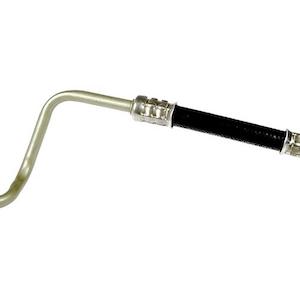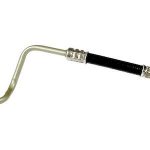In a conventional motor vehicle, the engine produces power, which runs through the gears and bearings or the transmission, and then drives the wheels. A great deal of heat is generated in this process. The engine has the primary cooling system, with a pump circulating coolant through a large radiator. The transmission has its own cooling system, which uses transmission fluid pumped through a smaller radiator, typically sitting in front of the engine radiator.
In some cases, the transmission cooler is inside the radiator, or it can be a small radiator mounted in front of the engine radiator. In some cases there are two transmission coolers; one inside the radiator as well as one mounted outside. This is more common on vehicles designed for towing, which have a much bigger job to do keeping the transmission fluid cool.
Whatever system is used will have a pair of solid metal lines (a supply line and a return line) running from the transmission to the cooler at the front of the vehicle. If there are two transmission coolers (the main cooler and an auxiliary cooler) there will also be lines connecting the two. Most often the lines are metal, with flexible hoses connecting between the engine assembly to the cooler fixed on the frame. If the flexible hoses have a replaceable clamp to the fixed lines, then replacement is usually just the flexible hoses. Many newer vehicles, however, use non-replaceable clamps, which means replacing the entire line and hose assembly. At their endpoints, cooler line assemblies ordinarily have push-fit clips to attach at the transmission and the cooler, which are relatively simple to undo. But how hard the assemblies are to replace depends on their routing through the tightly organized engine bay, which is the primary challenge.
The two transmission cooler lines or hoses are almost always replaced together. One option to replacing lines is having the lines rebuilt. In most cities, there are places equipped to make or rebuild hydraulic lines, which would be able to replace the leaking rubber lines and remake a factory-style crimp. The cost is usually about the same as for new lines, so this is more of a last resort if new lines are unavailable for some reason.
Costs of Transmission Cooler Line Replacement
On average for most vehicles, it costs about $300 to replace a pair of transmission cooler lines, though it can be cheaper on vehicles where just the rubber lines can be replaced rather than the whole assembly.
For some more specific examples on common vehicles, using $100 an hour as a labor rate:
For a 2013 Jeep Wrangler, the labor time to replace the transmission oil cooler line assembly is 1.2 hours. A factory cooler line set costs about $170, making the job about $300 using OE parts, and allowing for some cost of fluid. As with most vehicles, there isn’t any good aftermarket availability.
For a 2005 Honda Odyssey, the labor time to replace the cooler hoses is 2.8 hours. The hoses, in this case, are separable from the pipes, and factory pre-shaped hoses cost about $30. This makes the job about $320. There is also an available factory auxiliary cooler which can be installed as a kit, costing about $500 in total parts and labor.
For a 2011 Nissan Xterra with a 4.0 liter engine and factory-installed standard and auxiliary transmission coolers, the labor time to replace the hoses is 1.4 hours. The four hoses involved cost about $100 through dealer sources, making the job about $250 to replace the hoses. If there is no auxiliary cooler, then the job is basically half the cost in parts and labor, or about $125.
Some other vehicles that don’t use pre-formed hoses (mostly older vehicles) can be much cheaper for parts, where the appropriate hose is sold by the foot as necessary at auto parts stores.
What Goes Wrong with Transmission Cooler Lines
The main problem is leaks. On vehicles with replaceable hoses, they usually leak first at the clamp, where a rubber hose that has become old and hard will no longer hold a seal. Some types of clamps can be tightened, but if the hose has begun to degrade then replacement is the best long-term choice. On newer vehicles with non-replaceable hoses, cooler lines will usually leak at the crimp where the rubber line is clamped over the metal line. The crimps on those are made with a special machine and can’t be tightened, so when a connection leaks the normal solution is to replace the whole hose assembly.
hose that has become old and hard will no longer hold a seal. Some types of clamps can be tightened, but if the hose has begun to degrade then replacement is the best long-term choice. On newer vehicles with non-replaceable hoses, cooler lines will usually leak at the crimp where the rubber line is clamped over the metal line. The crimps on those are made with a special machine and can’t be tightened, so when a connection leaks the normal solution is to replace the whole hose assembly.
In theory, the failed crimp could be removed and a new clamp of a different kind installed, but this approach would have the disadvantages common to rebuilding vs. replacing many different kinds of parts. If a repaired part fails again a customer would expect it to be fixed for free, and the fix would likely be replacing the lines that had already been worked on. Doing a repair twice involves more time and expense than doing it once, and is generally avoided.
Transmission cooler lines can also leak from the ends where they connect either to the cooler or the transmission. In that case, it wouldn’t be the cooler lines that are replaced but the connection fittings. These are small screw-in parts that carry the seals that bear against the cooler pipes, and which are pretty simple and cheap to replace in most cases. It’s not unusual to replace the fittings at the same time as the hoses.
FAQ
It depends on the size of the leak. A “seep” is most common, where you can see wetness but no drips. That can go awhile. If there are drips it’s more important to get it fixed soon.
It can depend on how a vehicle is used, but heat is one of the main things that break down transmission fluid. Without a cooler, the transmission runs hotter and can suffer more wear and early failure.
Yes, it can be done. A leaking hose could be repaired in place, but a different clamp might not work well. The lines could also be sent out and rebuilt, but at about the cost of replacing with new most of the time.

